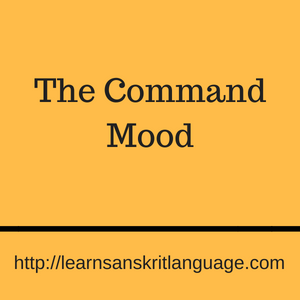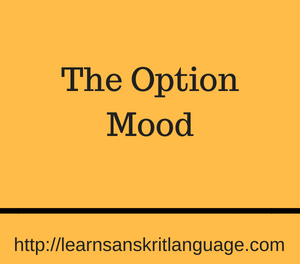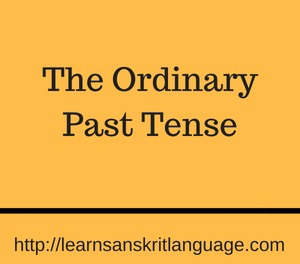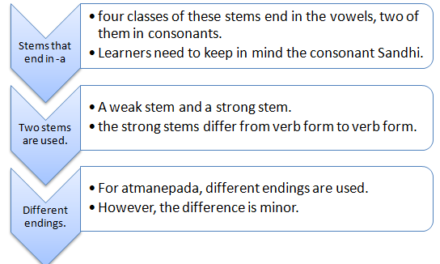The command mood was studied by us while studying the nouns. We shall now take a look at the other; these were P verbs belonging to simple verbs. Now we shall study some more of these kinds of verbs, however, you would be glad to know that these resemble the verbs we have been studying to a great extent.
Now we shall look at a few examples of these verbs, study their patterns and see how they differ in comparison to ordinary past tense. First let us look at P endings in the command mood.
Note: simple verbs and complex verbs both have the same kind of endings. Now let us look at the example.
| Singular | Plural | Dual | |
|---|---|---|---|
| Third person | भवतु bhavatu | भवन्तु bhavantu |
|
| Second person | भव bhava | ||
| First person | भवानि bhavāni | भवाव bhavāva | भवाम bhavāma |
DIFFERENCE FROM ORDINARY PAST TENSE:
In the first person, there would be an absence of visarga (a mark that was present in the ordinary past tense).
Now we shall look at a complex verb in parsmaipada verbs. Please look at the table given below. The verb is “su”. The ones in the strong form are given in Italics.
| Singular | Plural | Dual | |
|---|---|---|---|
| Third person | सुनोतु sunotu | सुन्वन्तु sunvantu |
|
| Second person | सुनु sunu | ||
| First person | सुनवानि sunavāni | सुनवाव sunavāva | सुनवाम sunavāma |
Now we shall look at the simple and complex verbs in Atmanepada verbs. The verbs we shall be taking are “labh” and “su”. But first we shall look at labh which is an example of simple verbs.
| Singular | Plural | Dual | |
|---|---|---|---|
| Third person | लभताम् labhatām | लभन्ताम् labhantām |
|
| Second person | लभस्व labhasva | ||
| First person | लभै labhai | लभावहै labhāvahai | लभामहै labhāmahai |
Now let us look at complex verbs and how similar or different they are. The ones who use the strong form are in italics.
| Singular | Plural | Dual | |
|---|---|---|---|
| Third person | सुनुताम् sunutām | सुन्वताम् sunvatām |
|
| Second person | सुनुष्व sunuṣva | ||
| First person | सुनवै sunavai | सुनवावहै sunavāvahai | सुनवामहै sunavāmahai |
It is important to note that there is a difference when it comes to the command mood in the complex verbs of Atmanepada and Parsmaipada.




